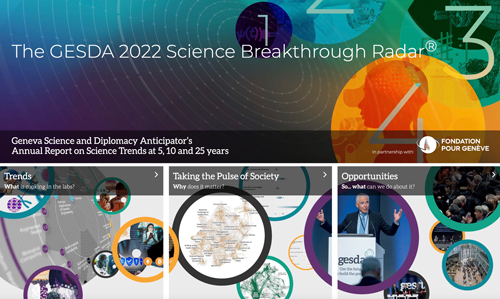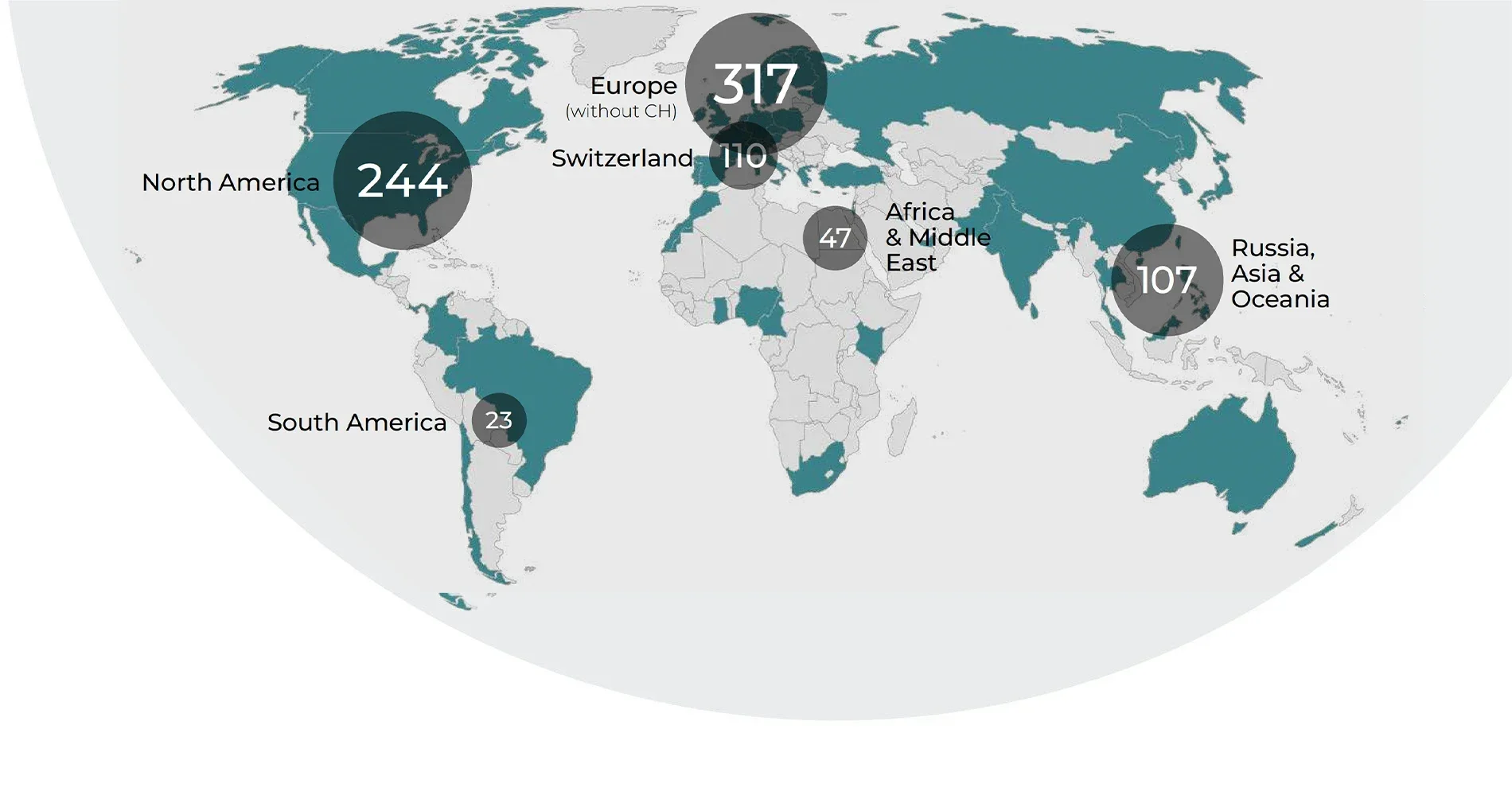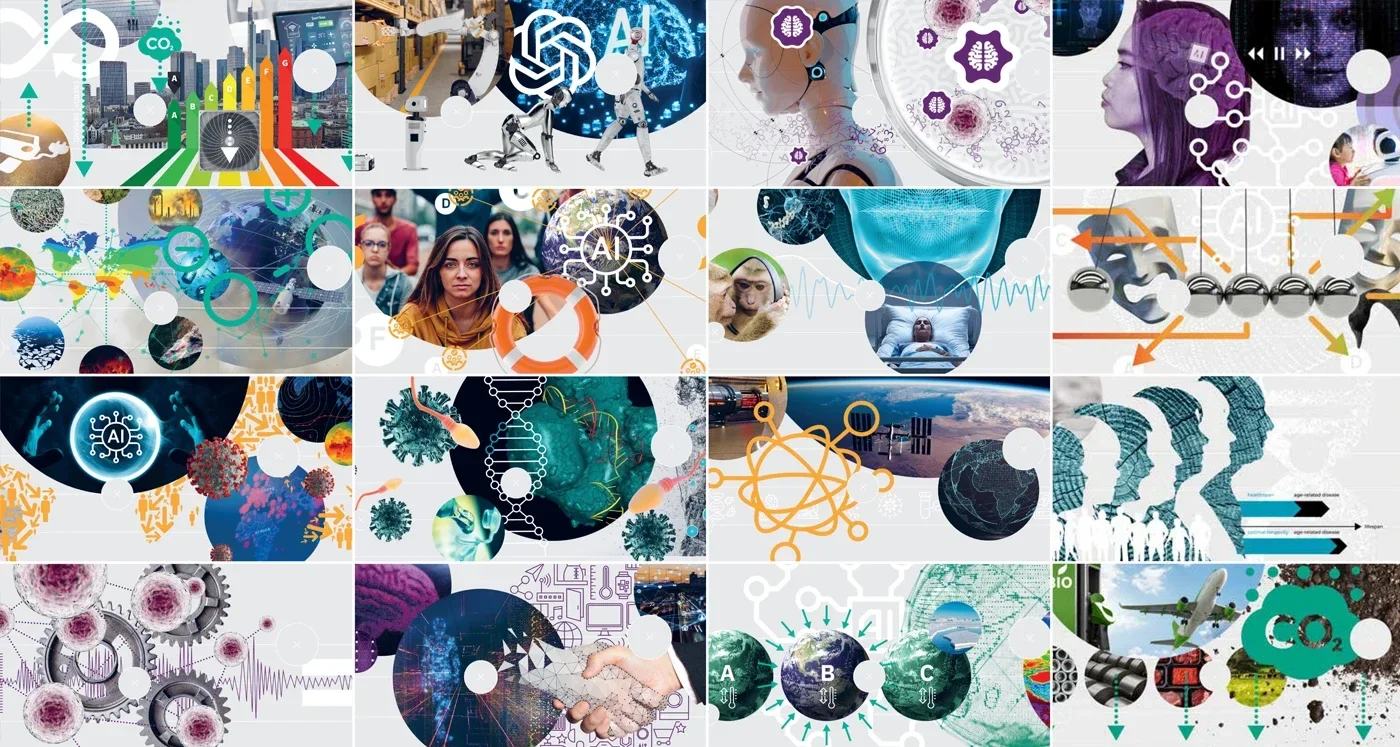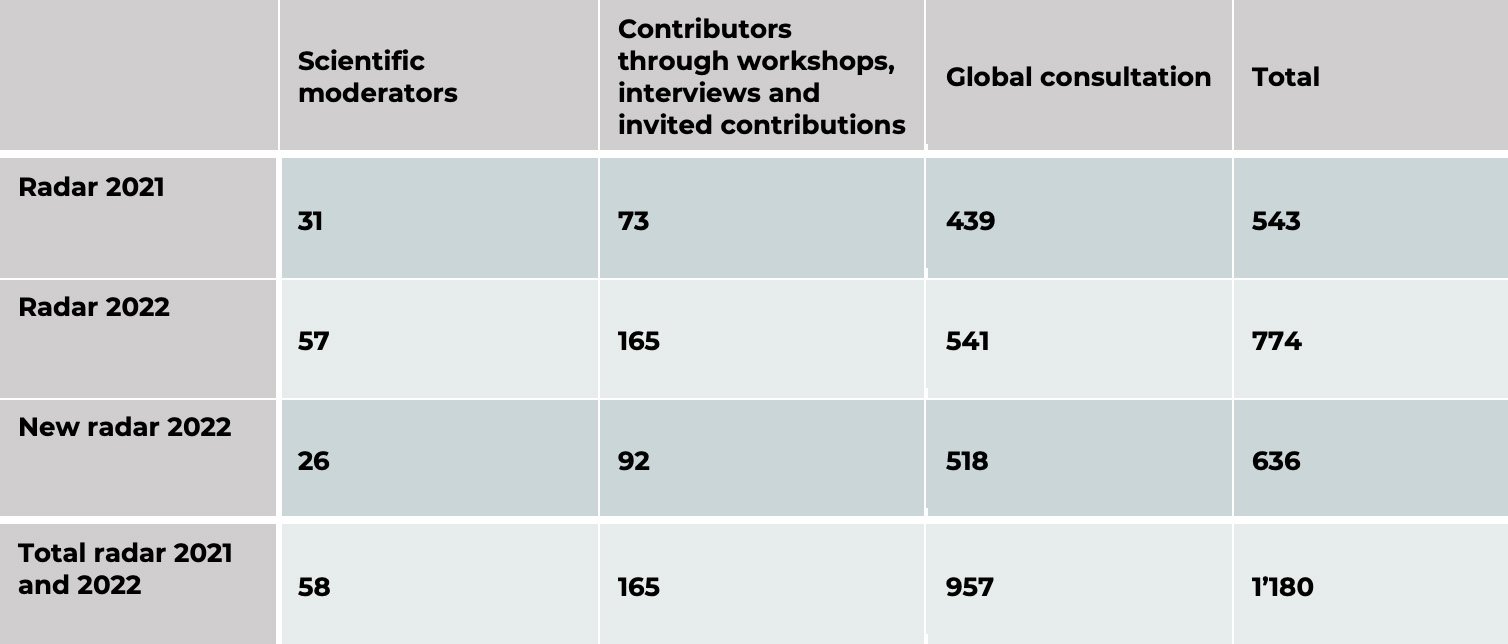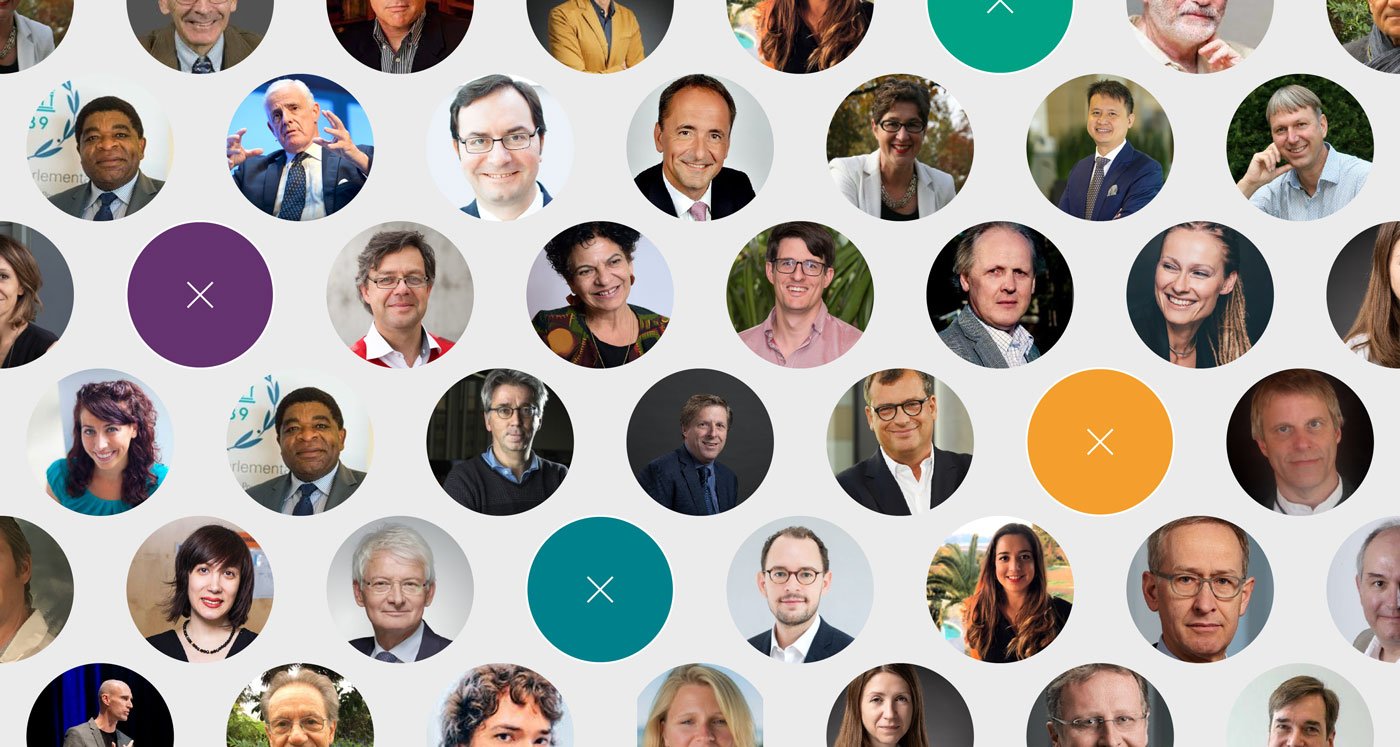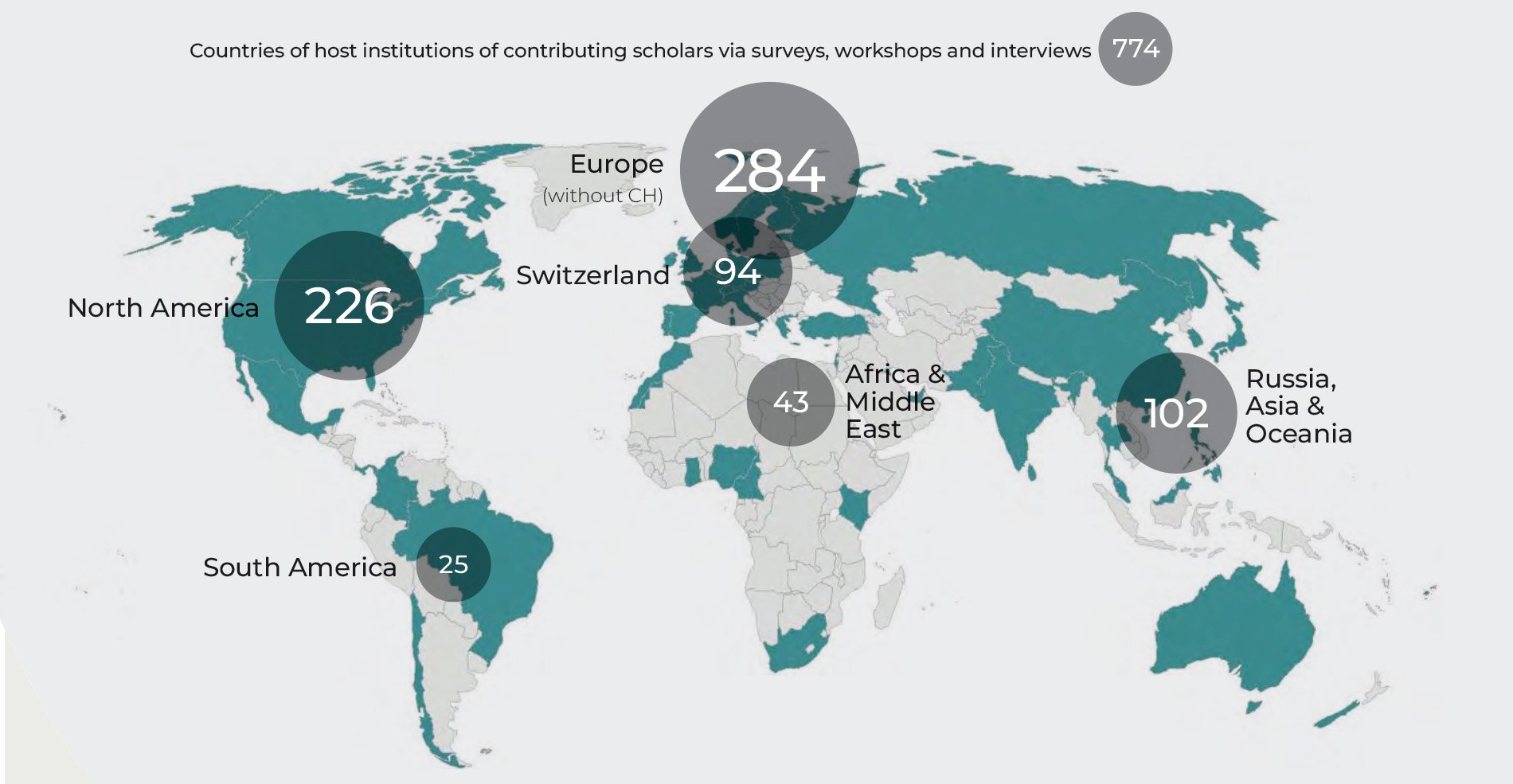Trends – Taking the pulse of science
GESDA created a methodology to harness the expertise of the members of its Academic Forum in assessing the relative importance of key scientific emerging topics and their impact on people, society and the planet.
The emerging topics are organised around 5 ‘Scientific Platforms’ with a view to determining what the current state of knowledge is, what the next frontiers will be, how a given scientific or technological field might develop in the coming years, and how that development could affect GESDA’s objectives. These platforms structure GESDA’s work, from anticipation to action along GESDA’s Anticipatory Situation Room methodology.
The five Scientific Platforms are:
- Quantum Revolution and Advanced Artificial Intelligence
- Human Augmentation
- Eco-regeneration and Geoengineering
- Science and Diplomacy
- Knowledge Foundations
Important definitions
GESDA defines a scientific emerging topic as an area at the boundaries of human knowledge for which future science and technology breakthroughs can be anticipated in the timeframe relevant to GESDA (see definition of breakthrough below). Those scientific emerging topics are areas where we expect developments with strong future impacts on the three fundamental GESDA questions about people, society, and the planet, and hence for which science anticipation is essential.
Within a scientific emerging topic, specific scientific breakthroughs are characterised by having a strong scientific momentum in the 5, 10 and 25 year time-frames, combined with a high potential impact on people, society and planet. Thus, these science breakthroughs constitute the core of GESDA’s mapping of scientific emerging topics at 5, 10 and 25 years.
The scientific emerging topics have been identified by GESDA’s Academic Forum and informed by the GESDA BestReads – a curated monthly overview of key scientific developments in the areas covered by the five scientific platforms. Invited contributions drafted by named authors nourish as well the pipeline of topics to consider for future editions by shedding the light on recent developments with strong potential.
Engaging leaders and selecting topics to be assessed - GESDA Academic Moderators
Since 2020, GESDA brought together an academic community of of more than 1500 scientists through workshops, interviews and global consultations. The goal of these discussions was to identify a set of emerging scientific topics that, in the eyes of the community, were critical to anticipate.
Out of those 1500 scientists, 84 are scientific moderators - curating and reviewing the breakthroughs briefs presented in the radar.
In addition, best on the BestReads, the invited contributions of the precedent editions and inputs from the GESDA Board of Directors and broader community, additional emerging topics have been added to the 2023 edition of the Radar.
Reviewing and updating past briefs edition – Engaging the scientific moderators
A key ambition of the GESDA Science Breakthrough Radar is to remain up-to-date and provide a rolling description of the current state-of-research and breakthrough predictions at 5, 10 and 25 years. To achieve this, past breakthrough briefs are being reviewed by the respective scientific moderators and updated accordingly. This review happens over a two years period, whereby we alternate light reviews and workshops over the two years, under the leadership of the scientific moderators. To the extent possible, the community of contributing scientists is renewed as well. This renewal provides additional perspectives on the anticipated advances.
In total, 84 scientific moderators have been engaged over the three Science Breakthrough Radar editions. Based on their inputs, the scope of each emerging topics is narrowed than, relevant sub-topics and potential breakthroughs are identified, and potential important developments of these over a 5, 10 and 25 year timeframe are defined. A critical part of this work, is the identification of four related research areas per topic, that together represented sub-domains of significance that are likely to drive progress in the overarching topic.
At least 1 and up to 3 scientific moderators per topic agreed to review and curate the briefs, providing the scientific legitimacy and credibility of the work. The scientific moderators are part of GESDA’s Academic Forum.
Engaging wider experts and assessing new topics - GESDA anticipation workshop series
The input of a broader community of experts on the emerging topics, initial list of sub-fields and draft breakthroughs predictions at 5, 10 and 25 years are being discussed with a broader community of scientists in the field. Between 2021 and 2023, 307 global experts have been engaged through targeted workshops. Their are listed in the contributor profiles section of the radar website. The same methodology was used for the 10 new emerging topics that have been integrated in the 2022 GESDA Science Breakthrough Radar. Between March and June 20 workshops with 104 participants.
The full set of topics and related research areas can be found in the trends explorer, via the link below.
Digging deeper - Villars anticipation workshops and thematic deep dives
The Villars anticipation workshops and deep dives on the Future of Peace and War, the Human Right to Science and the Philosophy lens are novel elements of the GESDA 2023 Science Breakthrough Radar. They are the results of multi-days intense onsite workshops, were scientists, scholars and experts from the relevant fields debate anticipatory issues in order to review and expand areas of the radar, identify gaps and propose future work.
The Villars anticipation workshop happen on a yearly basis at the level of one of the 5 scientific platforms. For the 2023 edition, Neuro-augmentation was selected.
Engaging the broad scientific community in a structured assessment of topics - the GESDA survey design
Building on the workshops and the experiences made in 2021, GESDA decided to use a survey instrument to assess the ‘Anticipation Potential’ of each of the topics along four dimensions:
- The expected time to maturity,
- The expected transformational effect across science and industries
- The current state of awareness among stakeholders and,
- possible impact on people, society and planet
The survey consists of six questions to assess those four dimensions. As a set, the survey invites respondents to assess four research areas within the topic as to its timing, level of convergence, level of awareness, potential pervasiveness and disruptiveness. A final question asked respondents to assess the existential impact for individuals, society and the environment for the topic as a whole. The research team made the following assumptions and designed the survey accordingly.
Expected time to maturity: The timing of significant advancements within a research field is an important factor in whether and how much to be concerned about it. GESDA focuses on advances that are not about to be deployed now but will be significant in the coming 25 years.
Expected transformational effect: This dimension combines three indicators, namely:
a. Convergence: Our hypothesis is that topics which systematically interface with others will have the greatest impact on humanity and society. For instance, the convergence among the bio-, nano-, and cogno-sciences has advanced research in these fields at an extraordinary pace and sped the application of this research. In the same vein, discoveries at the convergence between the natural and human sciences will have a strong transformational effect on society.
b. Presence: The more likely that a research area will result in pervasive advancements across industries, countries and communities, the higher its transformational effect.
c. Disruptiveness: The more likely that a research area will result in disruption across industries, countries and communities, the more important it is to anticipate today.
Awareness: The less widely discussed or considered a potentially important research domain is (beyond researchers, technologists and policy-makers focused on that specific area), the more important it may be to anticipate.
Existential impact: The more likely that the topic as a whole could a) change what it means to be human, b) change how we interact in society, and/or c) affect the sustainability of the planet, the more important it is to anticipate.
The GESDA survey response
Between April and June 2022, GESDA reached out to 8,680 experts in their fields. GESDA collaborated closely with the open science publisher Frontiers to identify members of their research community. The experts have been selected based on following criteria:
- Excellence in research, defined as H-index, citation rate and publication record
- Scientific expertise in GESDA’s scientific emerging topics
- Geographical coverage to the extent possible
Out of this expert pool, 848 scientists from 73 countries responded to the survey, which corresponds to a response rate of slighty less than 10% . In total, since 2021 1'151 researchers have responded to the survey.
The table below show the lists of contributors to the 2021 and 2022 editions of the Radar as scientific moderators, contributors and global experts. Overall more than 1’000 scientists from across the world contributed.
The following maps and tables show the country of host institutions of participating scientists in the survey, workshop series and interviews. The map does not show their country of origin, with for example many African, Asian and South American researchers established in US and European institutions.
For a list of scientific moderators and global experts consulted through workshops, interviews or written contributions, refer to the link below:
Detailed numbers per country of host institution
Europe
| Country | Responded |
|---|---|
| Switzerland | 110 |
| United Kingdom | 66 |
| Germany | 49 |
| France | 35 |
| Italy | 39 |
| Spain | 21 |
| Netherlands | 20 |
| Austria | 13 |
| Sweden | 11 |
| Portugal | 10 |
| Poland | 7 |
| Belgium | 7 |
| Ireland | 4 |
| Greece | 5 |
| Hungary | 4 |
| Denmark | 7 |
| Norway | 3 |
| Lithuania | 2 |
| Finland | 4 |
| Ukraine | 2 |
| Croatia | 2 |
| Romania | 2 |
| Bulgaria | 1 |
| Latvia | 1 |
| Luxembourg | 2 |
| Total | 427 |
North America
| Country | Responded |
|---|---|
| United States | 203 |
| Canada | 35 |
| Mexico | 5 |
| Costa Rica | 1 |
| Total | 244 |
South America
| Country | Responded |
|---|---|
| Brazil | 13 |
| Chile | 1 |
| Colombia | 4 |
| Argentina | 1 |
| Ecuador | 2 |
| Peru | 2 |
| Total | 23 |
Africa & Middle East
| Country | Contacted / Responded |
|---|---|
| South Africa | 13 |
| Israel | 9 |
| Tanzania | 3 |
| Turkey | 4 |
| Egypt | 3 |
| United Arab Emirates | 4 |
| Iran | 3 |
| Nigeria | 1 |
| Uganda | 1 |
| Morocco | 1 |
| Kenya | 1 |
| Saudi Arabia | 3 |
| Total | 47 |
Russia, Asia & Oceania
| Country | Contacted / Responded |
|---|---|
| Australia | 24 |
| Japan | 17 |
| India | 20 |
| China | 17 |
| Singapore | 7 |
| Philippines | 1 |
| South Korea | 4 |
| New Zealand | 6 |
| Indonesia | 3 |
| Malaysia | 2 |
| Pakistan | 1 |
| Russia | 1 |
| Afghanistan | 1 |
| Bangladesh | 1 |
| Viet Nam | 1 |
| Thailand | 1 |
| Nepal | 1 |
| Total | 107 |
Survey analysis
Responses to the survey were combined to create a single score representing “anticipation potential” using the following approach:
- Responses were analysed topic by topic
- Each question in the topic rendered a numerical value. The individual scores are taken as the average of each question from all valid responses.
- The timing score was normalised from a year figure to a score between 1 and 10. Both the timing and awareness scores were inverted to capture the fact that closer timing and lower awareness imply a greater need for anticipation
- The scores for convergence presence and disruptiveness were averaged to create a “transformational effect" score by topic
- The scores for timing, transformational effect and awareness were averaged to create a “sub-factor” for each topic.
- The scores for existential impact across the human, social and environmental domains were averaged to create an "existential impact" score by topic.
- The sub factor and existential impact scores were combined with a 75% - 25 % weighting to create a single “anticipation potential” score for each topic.
- Analysis was performed to test the robustness of relative results when changing the weighting of scores.
Methodological limitations
This methodology was designed to be rigorous within a range of constraints.
First, the selection of topics to be assessed was made inductively by a small set of GESDA’s academic community. As a result, this set of topics is biased towards the research inclinations, worldviews and concerns of the participating experts.
Second, the data gathered through the workshops and survey are not meant to be representative of any defined set of experts in any given field. Rather, GESDA's work on anticipation seeks to add value by surfacing a diversity of reactions and opinions. Hence, GESDA cast a wide net for respondents, without seeking to control specific representative ratios.
Third, the experts participating in GESDA's workshops and completing its survey tend to be senior scientists based in Europe or North America. While significant efforts were made to include gender and geographically diverse voices in workshops, the majority of survey respondents are experienced researchers based in Europe and Northern America. This biased can be explained by the selected topics, which are at the frontiers of science where developments happen only in the most advanced laboratories, and reflects one reality of science, as reflected by the H-index rankings, citations and publication rates (see for example the ranking provided by SCImago based on the Scopus database of publication and displayed in the table below).
Actions & Debates -Taking the pulse of society
The advances covered in the Science Breakthrough Radar are reshaping, or will reshape, how we see ourselves as human beings, the way we interact with each other and our relation to the environment. This means that that their applications, their potentials and implications are already being discussed broadly. These are important conversations, and the Actions & Debates section monitor public debate using a machine learning algorithm that analyses discussions on the world’s media and online social platforms that are focused around the emerging topics presented in the Radar. Through this, we aim to understand how discourse and sentiment about science and technology issues vary between regions, age groups and topics, and to identify the fields that require a broader societal debate.
In 2022, we have also innovated with a tool for monitoring civil society and private citizen activity around the scientific emerging topics included in the Radar. We looked at four areas of activity: raising of public awareness; entrepreneurial endeavours; policy-oriented action that shapes and drives discussions in society, and direct contributions to science and technology— by biohacking, participation in clinical trials or citizen science endeavours, for example. These observations are updated on a monthly basis on the Radar’s digital platform.
In 2023, we have innovated by analysing the evolution of sentiment on social and maintream media between 2021-2022 and 2022-2023.
Debates - What do people say?
We used the AI-based research and trend sensing tool “Deep View” has been used to capture, systematize and classify the opinions and discussions happening on social media on the scientific emerging topics described in the 2023 GESDA Science Breakthrough Radar. Deep View takes unstructured information and uses AI to mimic human comprehension and detect hidden patterns and interrelations. It applies Natural Language Processing algorithms on complex data sets composed of over 500,000 curated media sources and social media posts on Twitter, Facebook, Instagram, Reddit and Amazon reviews.
The insights were derived following a five-step iterative process with multiple quality checks:
- Specifying the search terms based on the GESDA taxonomy
- Searching the Moreover, LexisNexis Social Media data and searches for matches in articles/ posts and selecting a set of the most relevant articles/posts based on term frequency, inverse document frequency and term prominence within documents.
- Analysing articles by increasing relevance to identify key words to filter-out and the prominence of terms within documents
- Cloud Analysis: Out of the set of relevant and unique articles/posts the system selects up to 15,000 articles/posts to visualize based on the interconnectedness of ideas.
- Additional analyses conducted on sentiment, time series, traction to enrich insights. Sentiment takes into consideration semantic nuances including grammar and word strength (e.g. hate>dislike)
For integration in the report, we have selected the most salient positive, neutral and negative items and linked them to the other sections of the report.
Actions – What do people do?
For the first time, we attempted to monitor in real time the activities of civil society actors in areas related to the scientific emerging topics and breakthroughs described in the trend section of the report. The intention was to get an additional perspective about how citizens and small organisations are engaging with advanced science and detected interesting initiatives.
In partnership with Deloitte and the Gnosis AI tool, and with the advice of the small advisory group, a set of indicators has been created to provide a snapshot of actions by civil society actors. We define civil society actors as citizens and small non-governmental organisations Gnosis uses Natural Language Processing (NLP) algorithms to analyze qualitative text in various languages and extract meaningful information about the topic monitored. The tool specializes in the analysis of qualitative data (e.g., news, blogs), but can also analyze quantitative data (e.g., KPIs, statistics). The primary source of data is LexisNexis from which we draw >5 m. data points per day.
To guide the NLP algorithms specific indicators have been defined. Indicators are signs or markers that organize information in a way that the algorithms can measure one aspect of a business, social or political environment. This allows the tool to identify, monitor, and assess inherent changes and view them in a holistic overview across time, regions, industries and ecosystems.
For the 2022 GESDA Science Breakthrough Radar, we selected 4 indicators and run the algorithms on the four initial scientific platforms. The graph below provides an overview and description of the indicators.
Activities are monitored on a daily basis visualised through a dashboard that offers the indicator scores as counts of occurrence in the analysed data sets, the underlining variables that contributed to the scores, the snippets were the algorithm found an occurrence of the variable and trends which show which topics and which type of activities are gaining in importance. The findings are formalized in a quarterly update which is provided in the Science Breakthrough Radar digital platform.
The combined insights from the sentiment and activities analysed complement the descriptions of breakthroughs in the trend section and inform the direction of GESDA’s future work.
Opportunities -Taking the pulse of diplomacy
The final section of the GESDA Science Breakthrough Radar extends to the discussions that take place at the yearly High-Level Summit. The list of speakers, descriptions of session and full summit outcomes can be found at the following link: https://summit.gesda.global
The Open Quantum Institute Incubation Report presents the outcome of the work done by task force on quantum computing co-chaired by Matthias Troyer and Anousheh Ansari. The task force applied GESDA's Anticipatory Situtaiton Room methodology. Based on the insights in the Science Breakthrough Radar and discussions at the nexus between science and diplomacy, the OQI represents the first solution idea that has moved through all stages of the methodology.
